Theoretical Aspects of Thin Film Optical Spectra: Underlying Models, Model Restrictions and Inadequacies, Algorithms, and Challenges
Abstract
1. Introduction
- Physical modeling of both the system geometry and the material parameters;
- Forward search tasks concerning the calculation of spectrophotometric quantities only, no inverse problems;
- Specific effects arising from violations of the model assumptions in practice.
2. Basic Model Assumptions in Conventional Thin Film Optics
2.1. System Geometry
- We assume stratified media only. Consequently, the optical properties of the media shall depend on one coordinate (here, the z-coordinate, as seen in Figure 1) only. The optical parameters describing the materials may exhibit a discontinuous z-dependence, and in this case, the discontinuities in the optical parameters describe what we will further call interfaces. The interfaces are perpendicular to the z-axis.
- Consequently, the model system extends to infinity along the x- and y-axes.
- We further assume optical isotropy of all media. In addition, any magnetic response is neglected in our model.
- The semispace above the stratified medium is filled with a homogenous medium, called the incidence medium. As a postulate, light propagation in the incidence medium should be free of damping. On its bottom, the stratified medium faces a semispace filled with a further homogeneous medium, called the exit medium.
- It is assumed that a plane monochromatic electromagnetic wave is incident (from the incidence medium) on the stratified medium. In this case, an incident wavevector may be unambiguously defined. On this basis, an incidence angle may be introduced, which is zero for the particular case of normal incidence.
- At oblique light incidence, the wavevector of the incident wave and the z-axis allow the defining of an incidence plane.
- We further assume a three-wave scenario. That means that the incident wave gives rise to the generation of two other plane waves, propagating either in the exit medium (the transmitted wave) or in the incidence medium (the reflected wave).
- The materials are described in terms of linear optical constants only. As a consequence, reflectances and transmittances may be introduced that do not depend on the light intensity.
2.2. Material Description
2.2.1. Dispersion Models
2.2.2. Commonly Used Dispersion Models
2.2.3. Kramers–Kronig Consistency
3. Model Violations
3.1. General
3.2. Geometry
3.2.1. Restricted Beam Dimensions
3.2.2. Polarization Leakage
3.2.3. Rough Surfaces
3.2.4. Coherence
3.3. Materials
3.3.1. Optically Anisotropic Materials
3.3.2. Spatial Dispersion
3.3.3. Time-Dependent Material Properties
3.3.4. Non-Linear Response
3.3.5. Thickness-Dependent Optical Constants
4. Summary and Challenges
- i.
- They enable the user of commercial optical film calculation software to critically evaluate the practical value of a calculation result.
- ii.
- They enable the practitioner to understand the reason for discrepancies between the promised and measured performance of purchased thin film optical components.
- iii.
- They define important topics for the design of university courses on applied thin film spectroscopy.
Author Contributions
Funding
Data Availability Statement
Conflicts of Interest
References
- Film Wizard. Available online: https://sci-soft.com/product/film-wizard (accessed on 18 December 2024).
- FilmStar. Available online: https://ftgsoftware.com (accessed on 18 December 2024).
- Essential Macleod. Available online: https://www.thinfilmcenter.com/essential.php (accessed on 18 December 2024).
- OptiLayer. Available online: https://optilayer.com (accessed on 18 December 2024).
- OTF Studio. Available online: https://otfstudio.com (accessed on 18 December 2024).
- Tikhonravov, A.V. Some theoretical aspects of thin-film optics and their applications. Appl. Opt. 1993, 32, 5417–5426. [Google Scholar] [CrossRef] [PubMed]
- Thelen, A. Design of Optical Interference Coatings; McGraw-Hill Book Company: New York, NY, USA, 1989. [Google Scholar]
- Macleod, H.A. Thin-Film Optical Filters; Adam Hilger Ltd.: Bristol, UK, 1986. [Google Scholar]
- Furman, S.A.; Tikhonravov, A.V. Basics of Optics of Multilayer Systems; Edition Frontieres: Gif-sur-Yvette, France, 1992. [Google Scholar]
- Stenzel, O. The Physics of Thin Film Optical Spectra: An Introduction, 3rd ed.; Springer: Berlin/Heidelberg, Germany, 2024. [Google Scholar]
- Harbecke, B. Coherent and incoherent reflection and transmission of multilayer structures. Appl. Phys. B 1986, 39, 165–170. [Google Scholar] [CrossRef]
- Landau, D.; Lifshitz, E.M. Electrodynamics of Continuous Media; Volume 8 of A Course of Theoretical Physics; Pergamon Press: Oxford, UK, 1960. [Google Scholar]
- Yu, P.Y.; Cardona, M. Fundamentals of Semiconductors: Physics and Material Properties, 4th ed.; Springer: Berlin/Heidelberg, Germany, 2010. [Google Scholar]
- Gross, R.; Marx, A. Festkörperphysik; Walter de Gruyter GmbH: Berlin, Germany; Boston, MA, USA, 2014. [Google Scholar]
- Kittel, C. Introduction to Solid State Physics; John Wiley and Sons, Inc.: New York, NY, USA; London, UK; Sydney, Australia; Toronto, ON, Canada, 1971. [Google Scholar]
- Stenzel, O. Optical Coatings: Material Aspects in Theory and Practice; Springer: Berlin/Heidelberg, Germany, 2014. [Google Scholar]
- Brendel, R.; Bormann, D. An infrared dielectric function model for amorphous solids. J. Appl. Phys. 1992, 71, 1–6. [Google Scholar] [CrossRef]
- Wilbrandt, S.; Stenzel, O. Empirical extension to the multioscillator model: The beta-distributed oscillator model. Appl. Opt. 2017, 56, 9892–9899. [Google Scholar] [CrossRef]
- Stenzel, O.; Wilbrandt, S. Beta-distributed oscillator model as an empirical extension to the Lorentzian oscillator model: Physical interpretation of the β_do model parameters. Appl. Opt. 2019, 58, 9318–9325. [Google Scholar] [CrossRef]
- Jellison, G.E.; Modine, F.A. Parameterization of the optical functions of amorphous materials in the interband region. Appl. Phys. Lett. 1996, 69, 371–373. [Google Scholar] [CrossRef]
- Jellison, G.E. Spectroscopic ellipsometry data analysis: Measured versus calculated quantities. Thin Solid Films 1998, 313–314, 33–39. [Google Scholar] [CrossRef]
- Ferlauto, A.; Ferreira, G.; Pearce, J.M.; Wronski, C.; Collins, R.; Deng, X.; Ganguly, G. Analytical model for the optical functions of amorphous semiconductors from the near-infrared to ultraviolet: Applications in thin film photovoltaics. J. Appl. Phys. 2002, 92, 2424–2436. [Google Scholar] [CrossRef]
- Forouhi, R.A.; Bloomer, I. Optical dispersion relations for amorphous semiconductors and amorphous dielectrics. Phys. Rev. B Condens. Matter 1986, 34, 7018–7026. [Google Scholar] [CrossRef]
- Franta, D.; Nečas, D.; Ohlídal, I. Universal dispersion model for characterization of optical thin films over a wide spectral range: Application to hafnia. Appl. Opt. 2015, 54, 9108–9119. [Google Scholar] [CrossRef]
- Franta, D.; Vohánka, J.; Čermák, M. Universal Dispersion Model for Characterization of Thin Films Over Wide Spectral Range. In Optical Characterization of Thin Solid Films; Stenzel, O., Ohlídal, M., Eds.; Springer Series in Surface Sciences; Springer: Cham, Switzerland, 2018; Volume 64. [Google Scholar]
- Born, M.; Wolf, E. Principles of Optics; Pergamon Press: Oxford, UK; London, UK; Edinburgh, UK; New York, NY, USA; Paris, France; Frankfurt, Germany, 1968. [Google Scholar]
- Grosse, P. Freie Elektronen in Festkörpern; Springer: Berlin/Heidelberg, Germany; New York, NY, USA, 1979. [Google Scholar]
- Stenzel, O.; Wilbrandt, S.; Friedrich, K.; Kaiser, N. Realistische Modellierung der NIR/VIS/UV-optischen Konstanten dünner optischer Schichten im Rahmen des Oszillatormodells. Vak. Forsch. Prax. 2009, 21, 15–23. [Google Scholar] [CrossRef]
- Stenzel, O. Light-Matter Interaction: A Crash Course for students of Optics, Photonics and Material Science; Springer: Berlin/Heidelberg, Germany, 2022. [Google Scholar]
- Tauc, J.; Grigorovici, R.; Vancu, A. Optical properties and electronic structure of amorphous germanium. Phys. Status Solidi (b) 1966, 15, 627–637. [Google Scholar] [CrossRef]
- Zallen, R. Jan Tauc and the optical properties of crystalline and amorphous semiconductors. J. Non-Cryst. Solids 1992, 141, vii–viii. [Google Scholar] [CrossRef]
- Mott, N.F.; Davis, E.A. Electronic Processes in Non-Crystalline Materials; Clarendon Press: Oxford, UK, 1979; Chapter 6. [Google Scholar]
- Janicki, V. Design and Optical Characterization of Hybrid Thin Film Systems. Ph.D. Thesis, Faculty of Science, University of Zagreb, Zagreb, Croatia, 2007. [Google Scholar]
- Franta, D.; Nečas, D.; Zajíčková, L.; Ohlídal, I.; Stuchlík, J.; Chvostová, D. Application of sum rule to the dispersion model of hydrogenated amorphous silicon. Thin Solid Films 2013, 539, 233–244. [Google Scholar] [CrossRef]
- Cody, G.D. Semiconductors and Semimetals; Pankove, J.I., Ed.; Academic: Orlando, FL, USA, 1984; Volume 21B, p. 1. [Google Scholar]
- Orosco, J.; Coimbra, C.F.M. On a causal dispersion model for the optical properties of metals. Appl. Opt. 2018, 57, 5333–5347. [Google Scholar] [CrossRef]
- Campi, D.; Coriasso, C. Relationships between optical properties and band parameters in amorphous tetrahedrally bonded materials. Mater. Lett. 1988, 7, 134–137. [Google Scholar] [CrossRef]
- Campi, D.; Coriasso, C. Prediction of optical properties of amorphous tetrahedrally bounded materials. J. Appl. Phys. 1988, 64, 4128–4134. [Google Scholar] [CrossRef]
- Franta, D.; Čermák, M.; Vohánka, J.; Ohlídal, I. Dispersion models describing interband electronic transitions combining Tauc’s law and Lorentz model. Thin Solid Films 2017, 631, 12–22. [Google Scholar] [CrossRef]
- Franta, D.; Nečas, D.; Zajíčková, L. Application of Thomas–Reiche–Kuhn sum rule to construction of advanced dispersion models. Thin Solid Films 2013, 534, 432–441. [Google Scholar] [CrossRef]
- Finkenrath, H. The Moss rule and the influence of doping on the optical dielectric constant of semiconductors—I. Infrared Phys. 1988, 28, 327–332. [Google Scholar] [CrossRef]
- Goos, F.; Hänchen, H. Ein neuer und fundamentaler Versuch zur Totalreflexion. Ann. Phys. 1947, 436, 333–346. [Google Scholar] [CrossRef]
- Artmann, K. Berechnung der Seitenversetzung des totalreflektierten Strahles. Ann. Phys. 1948, 437, 87–102. [Google Scholar] [CrossRef]
- Fuqua, P.D.; Brames, B.; Barrie, J.D.; DeSain, J.D.; Hendricks, W. Observation of lateral shifts in coatings for dichroic beamsplitters. In Optical Interference Coatings; OSA Technical Digest; Optica Publishing Group: Washington, DC, USA, 2019; poster TE.8. [Google Scholar]
- Lai, H.M.; Chan, S.W. Large and negative Goos–Hänchen shift near the Brewster dip on reflection from weakly absorbing media. Opt. Lett. 2002, 27, 680–682. [Google Scholar] [CrossRef] [PubMed]
- Wang, L.G.; Chen, H.; Zhu, S.Y. Large negative Goos-Hänchen shift from a weakly absorbing dielectric slab. Opt. Lett. 2005, 30, 2936–2938. [Google Scholar] [CrossRef]
- Wild, W.J.; Giles, C.L. Goos-Hänchen shifts from absorbing media. Phys. Rev. A 1982, 25, 2099–2101. [Google Scholar] [CrossRef]
- Merano, M.; Aiello, A.; ’t Hooft, G.W.; van Exter, M.P.; Eliel, E.R.; Woerdman, J.P. Observation of Goos-Hänchen shifts in metallic reflection. Opt. Express 2007, 15, 15928–15934. [Google Scholar] [CrossRef]
- Leung, P.T.; Chen, C.W.; Chiang, H.-P. Large negative Goos–Hänchen shift at metal surfaces. Opt. Commun. 2007, 276, 206–208. [Google Scholar] [CrossRef]
- Hendrix, K.D.; Carniglia, C.K. Path of a beam of light through an optical coating. Appl. Opt. 2006, 45, 2410–2421. [Google Scholar] [CrossRef]
- Gerken, M.; Miller, D.A.B. Multilayer thin-film coatings for optical communication systems. In Proceedings of the Optical Interference Coatings, Tucson, AZ, USA, 27 June–4 July 2004; OSA Technical Digest Series. Optica Publishing Group: Washington, DC, USA, 2004; p. ThD2/ThF2. [Google Scholar]
- Gerken, M.; Miller, D.A.B. Multilayer thin-film structures with high spatial dispersion. Appl. Opt. 2003, 42, 1330–1345. [Google Scholar] [CrossRef]
- Macleod, A. Thin Film Polarizers and Polarizing Beam Splitters. JVC Summer Bull. 2009, 24–29. [Google Scholar]
- Pezzaniti, J.L.; Chipman, R.A. Angular dependence of polarizing beam-splitter cubes. Appl. Opt. 1994, 33, 1916–1929. [Google Scholar] [CrossRef] [PubMed]
- Li, L.; Dobrowolski, J.A. High-performance thin-film polarizing beam splitter operating at angles greater than the critical angle. Appl. Opt. 2000, 39, 2754–2771. [Google Scholar] [CrossRef] [PubMed]
- Tikhonravov, A.V.; Trubetskov, M.K.; Tikhonravov, A.A.; Duparré, A. Effects of interface roughness on the spectral properties of thin films and multilayers. Appl. Opt. 2003, 42, 5140–5148. [Google Scholar] [CrossRef] [PubMed]
- Aspnes, D.E.; Theeten, J.B.; Hottier, F. Investigation of effective-medium models of microscopic surface roughness by spectroscopic ellipsometry. Phys. Rev. B 1979, 20, 3292–3302. [Google Scholar] [CrossRef]
- Qiyuan, J.; Tang, J.; Wu, S.; Jian, Y.; Tan, Z.; Zhang, W. Reflectance and transmittance model for multilayer optical coatings with roughness at oblique incidence. Thin Solid Films 2015, 592 Pt B, 305–311. [Google Scholar] [CrossRef]
- Rice, S.O. Reflection of Electromagnetic Waves from Slightly Rough Surfaces. Commun. Pure Appl. Math. 1951, 4, 351–378. [Google Scholar] [CrossRef]
- Bennett, H.E.; Porteus, J.O. Relation Between Surface Roughness and Specular Reflectance at Normal Incidence. J. Opt. Soc. Am. 1961, 51, 123–129. [Google Scholar] [CrossRef]
- Nagata, K.; Nishiwaki, J. Reflection of Light from Filmed Rough Surface: Determination of Film Thickness and rms Roughness. Jpn. J. Appl. Phys. 1967, 6, 251–257. [Google Scholar] [CrossRef]
- Filiński, I. The Effects of Sample Imperfections on Optical Spectra. Phys. Status Solidi (b) 1972, 49, 577–588. [Google Scholar] [CrossRef]
- Ohlidal, I.; Lukeš, F.; Navràtil, K. Rough silicon surfaces studied by optical methods. Surf. Sci. 1974, 45, 91–116. [Google Scholar] [CrossRef]
- Eastman, J.M. Scattering by all-dielectric multilayer bandpass filters and mirrors for lasers. In Physics of Thin Films; Hass, G., Francombe, M.H., Eds.; Academic Press: New York, NY, USA, 1978; Volume 10, pp. 167–226. [Google Scholar]
- Carniglia, C.K. Scalar scattering theory for multilayer optical coatings. Opt. Eng. 1979, 18, 104–115. [Google Scholar] [CrossRef]
- Hunderi, O. Optics of rough surfaces, discontinuous films and heterogeneous materials. Surf. Sci. 1980, 96, 1–31. [Google Scholar] [CrossRef]
- Huiser, A.M.J.; Baltes, H.P. Electromagnetic scattering by perfectly conducting rough surfaces; facet model. Opt. Commun. 1981, 40, 1–4. [Google Scholar] [CrossRef]
- Karnicka-Moscicka, K.; Kisiel, A. Surface roughness as possible explanation of differences in fundamental reflectivity spectra of Cd3As2. Surf. Sci. Lett. 1982, 121, L545–L552. [Google Scholar]
- Jezierski, K.; Misiewicz, J. Surface roughness as a physical cause of the dip in the results of a Kramers–Kronig analysis of Zn3P2. J. Opt. Soc. Am. B 1984, 1, 850–852. [Google Scholar] [CrossRef]
- Szcyrbrowski, J.; Schmalzbauer, K.; Hoffmann, H. Optical properties of rough thin films. Thin Solid Films 1985, 130, 57–73. [Google Scholar] [CrossRef]
- Petrich, R.; Stenzel, O. Modeling of transmittance, reflectance and scattering of rough polycrystalline CVD diamond layers in application to the determination of optical constants. Opt. Mater. 1994, 3, 65–76. [Google Scholar] [CrossRef]
- Mitsas, C.L.; Siapkas, D.I. Generalized matrix method for analysis of coherent and incoherent reflectance and transmittance of multilayer structures with rough surfaces, interfaces, and finite substrates. Appl. Opt. 1995, 34, 1678–1683. [Google Scholar] [CrossRef]
- Yin, Z.; Tan, H.S.; Smith, F.W. Determination of the optical constants of diamond films with a rough growth surface. Diam. Relat. Mater. 1996, 5, 1490–1496. [Google Scholar] [CrossRef]
- Carniglia, C.K.; Jensen, D.G. Single-layer model for surface roughness. Appl. Opt. 2002, 41, 3167–3171. [Google Scholar] [CrossRef]
- Katsidis, C.C.; Siapkas, D.I. General transfer-matrix method for optical multilayer systems with coherent, partially coherent, and incoherent interference. Appl. Opt. 2002, 41, 3978–3987. [Google Scholar] [CrossRef] [PubMed]
- Zhu, Q.Z.; Lee, H.J.; Zhang, Z.M. The Validity of Using Thin-Film Optics in Modeling the Bidirectional Reflectance of Coated Rough Surfaces. In Proceedings of the 37th AIAA Thermophysics Conference, Portland, OR, USA, 28 June–1 July 2004. AIAA 2004-2679. [Google Scholar]
- Lee, B.J.; Khuu, V.P.; Zhang, Z.M. Partially Coherent Spectral Transmittance of Dielectric Thin Films with Rough Surfaces. J. Thermophys. Heat Transf. 2005, 19, 360–366. [Google Scholar] [CrossRef]
- Murphy, A.B. Modified Kubelka–Munk model for calculation of the reflectance of coatings with optically-rough surfaces. J. Phys. D Appl. Phys. 2006, 39, 3571–3581. [Google Scholar] [CrossRef]
- Harvey, J.; Krywonos, A.; Vernold, C.L. Modified Beckmann-Kirchhoff scattering model for rough surfaces with large incident and scattering angles. Opt. Eng. 2007, 46, 078002. [Google Scholar] [CrossRef]
- Franta, D.; Ohlídal, I.; Nečas, D. Influence of cross-correlation effects on the optical quantities of rough films. Opt. Express 2008, 16, 7789–7803. [Google Scholar] [CrossRef]
- Ohlídal, I.; Nečas, D. Influence of shadowing on ellipsometric quantities of randomly rough surfaces and thin films. J. Mod. Opt. 2008, 55, 1077–1099. [Google Scholar] [CrossRef]
- Schröder, S.; Herffurth, T.; Blaschke, H.; Duparré, A. Angle-resolved scattering: An effective method for characterizing thin-film coatings. Appl. Opt. 2011, 50, C164–C171. [Google Scholar] [CrossRef]
- Schröder, S.; Duparré, A.; Coriand, L.; Tünnermann, A.; Penalver, D.H.; Harvey, J.E. Modeling of light scattering in different regimes of surface roughness. Opt. Express 2011, 19, 9820–9835. [Google Scholar] [CrossRef]
- Yin, Z.; Tan, H.S.; Smith, F.W. Measurement and Modeling of Optical Constants for Rough Surface Diamond Thin Films. MRS Online Proc. Libr. 2011, 416, 205–210. [Google Scholar] [CrossRef]
- Guo, C.; Kong, M.; Gao, W.; Li, B. Simultaneous determination of optical constants, thickness, and surface roughness of thin film from spectrophotometric measurements. Opt. Lett. 2013, 38, 40–42. [Google Scholar] [CrossRef]
- Nečas, D.; Ohlídal, I.; Franta, D.; Ohlídal, M.; Čudek, V.; Vodák, J. Measurement of thickness distribution, optical constants, and roughness parameters of rough nonuniform ZnSe thin films. Appl. Opt. 2014, 53, 5606–5614. [Google Scholar] [CrossRef] [PubMed]
- Nečas, D.; Ohlídal, I. Consolidated series for efficient calculation of the reflection and transmission in rough multilayers. Opt. Express 2014, 22, 4499–4515. [Google Scholar] [CrossRef] [PubMed]
- Vohánka, J.; Ohlídal, I.; Buršíková, V.; Klapetek, P.; Kaur, N.J. Optical characterization of inhomogeneous thin films with randomly rough boundaries. Opt. Express 2022, 30, 2033–2047. [Google Scholar] [CrossRef]
- Trost, M.; Schröder, S. Roughness and Scatter in Optical Coatings. In Optical Characterization of Thin Solid Films; Stenzel, O., Ohlídal, M., Eds.; Springer Series in Surface Sciences; Springer: Cham, Switzerland, 2018; Volume 64. [Google Scholar]
- Vohánka, J.; Šulc, V.; Ohlídal, I.; Ohlídal, M.; Klapetek, P. Optical method for determining the power spectral density function of randomly rough surfaces by simultaneous processing of spectroscopic reflectometry, variable-angle spectroscopic ellipsometry and angle-resolved scattering data. Optik 2023, 280, 170775. [Google Scholar] [CrossRef]
- Ohlídal, I.; Vohánka, J.; Dvořák, J.; Buršíková, V.; Klapetek, P. Determination of Optical and Structural Parameters of Thin Films with Differently Rough Boundaries. Coatings 2024, 14, 1439. [Google Scholar] [CrossRef]
- Yeh, P. Optical Waves in Layered Media, 2nd ed.; Wiley, John & Sons: Hoboken, NJ, USA, 2005. [Google Scholar]
- Postava, K.; Yamaguchi, T.; Kantor, R. Matrix description of coherent and incoherent light reflection and transmission by anisotropic multilayer structures. Appl. Opt. 2002, 41, 2521–2531. [Google Scholar] [CrossRef]
- Chen, G.; Tien, C.L. Partial Coherence Theory of Thin Film Radiative Properties. J. Heat Transf. 1992, 114, 636–643. [Google Scholar] [CrossRef]
- Richter, K.; Chen, C.; Tien, C. Partial coherence theory of multilayer thin-film optical properties. Proc. SPIE 1993, 1821, 284–295. [Google Scholar]
- Troparevsky, M.C.; Sabau, A.S.; Lupini, A.R.; Zhang, Z. Transfer-matrix formalism for the calculation of optical response in multilayer systems: From coherent to incoherent interference. Opt. Express 2010, 18, 24715–24721. [Google Scholar] [CrossRef]
- Lee, W.; Lee, S.Y.; Kim, J.; Kim, S.C.; Lee, B. A numerical analysis of the effect of partially-coherent light in photovoltaic devices considering coherence length. Opt. Express 2012, 20, A941–A953. [Google Scholar] [CrossRef]
- Puhan, J.; Bűrmen, Á.; Tuma, T.; Fajfar, I. Irradiance in Mixed Coherent/Incoherent Structures: An Analytical Approach. Coatings 2019, 9, 536. [Google Scholar] [CrossRef]
- Santbergen, R.; Smets, A.H.M.; Zeman, M. Optical model for multilayer structures with coherent, partly coherent and incoherent layers. Opt. Express 2013, 21, A262–A267. [Google Scholar] [CrossRef] [PubMed]
- Stathopoulos, N.A.; Savaidis, S.P.; Botsialas, A.; Ioannidis, Z.C.; Georgiadou, D.G.; Vasilopoulou, M.; Pagiatakis, G. Reflection and transmission calculations in a multilayer structure with coherent, incoherent, and partially coherent interference, using the transmission line method. Appl. Opt. 2015, 54, 1492–1504. [Google Scholar] [CrossRef]
- Azzam, R.M.A.; Bashara, N.M. Ellipsometry and Polarized Light; Elsevier: Amsterdam, The Netherlands, 1987. [Google Scholar]
- Röseler, A. Infrared Spectroscopic Ellipsometry; John Wiley & Sons Canada, Limite: Toronto, ON, Canada, 1990. [Google Scholar]
- Schubert, M. Infrared Ellipsometry on Semiconductor Layer Structures Phonons, Plasmons, and Polaritons; Springer: Berlin/Heidelberg, Germany, 2005. [Google Scholar]
- J.A. Woollam. WVASE. Available online: https://www.jawoollam.com/ellipsometry-software/wvase (accessed on 20 December 2024).
- Sentech SpectraRay/4. Available online: https://www.sentech.com/products/spectraray-4 (accessed on 20 December 2024).
- Weber, M.F.; Stover, C.A.; Gilbert, L.R.; Nevitt, T.J.; Ouderkirk, A.J. Giant Birefringent Optics in Multilayer Polymer Mirrors. Science 2000, 287, 2451–2456. [Google Scholar] [CrossRef]
- Strharsky, R.; Wheatley, J. Polymer Optical Interference Filters. Opt. Photonic News 2002, 13, 34–40. [Google Scholar] [CrossRef]
- Kreibig, U.; Vollmer, M. Optical Properties of Metal Clusters; Springer Series in Material Science; Springer: Berlin/Heidelberg, Germany, 1995. [Google Scholar]
- Rockstuhl, C.; Menzel, C.; Paul, T.; Pshenay-Severin, E.; Falkner, M.; Helgert, C.; Chipouline, A.; Pertsch, T.; Śmigaj, W.; Yang, J.; et al. Effective properties of metamaterials. Proc. SPIE 2011, 8104, 81040E. [Google Scholar]
- Ziman, J.M. Principles of the Theory of Solids; Cambridge University Press: Cambridge, UK, 1972. [Google Scholar]
- Penn, D.R. Wave-number-dependent dielectric function of semiconductors. Phys. Rev. 1962, 128, 2093–2097. [Google Scholar] [CrossRef]
- Zadeh, A. Frequency Analysis of Variable Networks. Proc. IRE 1950, 38, 291–299. [Google Scholar] [CrossRef]
- Morgenthaler, F.R. Velocity Modulation of Electromagnetic Waves. IRE Trans. Microw. Theory Tech. 1958, 6, 167–172. [Google Scholar] [CrossRef]
- Engheta, N. Four-dimensional optics using time-varying metamaterials. Science 2023, 379, 1190–1191. [Google Scholar] [CrossRef]
- Klingshirn, C.F. Semiconductor Optics; Springer: Berlin/Heidelberg, Germany, 1997. [Google Scholar]
- Landau, L.D.; Lifshitz, E.M. Mechanics; Elsevier: Amsterdam, The Netherlands, 1976. [Google Scholar]
- Pacheco-Pena, V.; Engheta, N. Antireflection temporal coatings. Optica 2020, 7, 323–331. [Google Scholar] [CrossRef]
- Engheta, N. Metamaterials with high degrees of freedom: Space, time, and more. Nanophotonics 2021, 10, 639–642. [Google Scholar] [CrossRef]
- Schubert, M.; Wilhelmi, B. Einführung in die nichtlineare Optik I und II; (engl.: Introduction in Non-Linear Optics I and II); BSB B. G. Teubner Verlagsgesellschaft: Leipzig, Germany, 1971. [Google Scholar]
- Buck, M.; Eisert, F.; Fischer, J.; Grunze, M.; Träger, F. Investigation of Self-Organizing Thiol Films by Optical Second Harmonic Generation and X-Ray Photoelectron Spectroscopy. Appl. Phys. A 1991, 53, 552–556. [Google Scholar] [CrossRef]
- Rodríguez, C.; Rudolph, W. Modeling third-harmonic generation from layered materials using nonlinear optical matrices. Opt. Express 2014, 22, 25984–25992. [Google Scholar] [CrossRef]
- Razskazovskaya, O.; Luu, T.T.; Trubetskov, M.; Goulielmakis, E.; Pervak, V. Nonlinear Behavior and Damage of Dispersive Multilayer Optical Coatings Induced by Two-Photon Absorption. Proc. SPIE 2014, 9237, 92370L1–92370L8. [Google Scholar]
- Amotchkina, T.; Trubetskov, M.; Fedulova, E.; Fritsch, K.; Pronin, O.; Krausz, F.; Pervak, V. Characterization of Nonlinear Effects in Edge Filters. In Proceedings of the Optical Interference Coatings (OIC), Tucson, AZ, USA, 19–24 June 2016; p. ThD.3. [Google Scholar]
- Pervak, V. Highly-dispersive mirrors reach new levels of dispersion. In Proceedings of the Optical Interference Coatings (OIC), Tucson, AZ, USA, 19–24 June 2016; p. ThD.1. [Google Scholar]
- Grossmann, F. Theoretical Femtosecond Physics, 3rd ed.; Springer: Berlin/Heidelberg, Germany, 2018; Chapter 1. [Google Scholar]
- He, J.Y. Numerical Study of Nonlinear Response in Dielectric Multilayer Mirrors; Research lab Report, Abbe School of Photonics; Friedrich-Schiller-Universität Jena: Jena, Germany, 2021. [Google Scholar]
- Razskazovskaya, O.; Luu, T.T.; Trubetskov, M.; Goulielmakis, E.; Pervak, V. Non-linear absorbance in dielectric multilayers. Optica 2015, 2, 803–811. [Google Scholar] [CrossRef]
- Stenzel, O.; Wilbrandt, S. Theoretical study of multilayer coating reflection taking into account third-order optical nonlinearities. Appl. Opt. 2018, 57, 8640–8647. [Google Scholar] [CrossRef]
- Stenzel, O.; Wilbrandt, S.; Mühlig, C.; Schröder, S. Linear and Nonlinear Absorption of Titanium Dioxide Films Produced by Plasma Ion-Assisted Electron Beam Evaporation: Modeling and Experiments. Coatings 2020, 10, 59. [Google Scholar] [CrossRef]
- Sheik-Bahae, M.; Hutchings, D.C.; Hagan, D.J.; Van Stryland, E.W. Dispersion of Bound Electronic Nonlinear Refraction in Solids. IEEE J. Quantum Electron. 1991, 27, 1296–1309. [Google Scholar] [CrossRef]
- Tichá, H.; Tichý, L. Semiempirical relation between non-linear susceptibility (refractive index), linear refractive index and optical gap and its application to amorphous chalcogenides. J. Optoelectron. Adv. Mater. 2002, 4, 381–386. [Google Scholar]
- Fournier, J.; Snitzer, E. The nonlinear refractive index of glass. IEEE J. Quantum Electron. 1974, 10, 473–475. [Google Scholar] [CrossRef]
- Stenzel, O. Simplified expression for estimating the nonlinear refractive index of typical optical coating materials. Appl. Opt. 2017, 56, C21–C23. [Google Scholar] [CrossRef] [PubMed]
- Wang, C.C. Empirical Relation between the Linear and the third-order Nonlinear Optical Susceptibilities. Phys. Rev. B 1970, 2, 2045–2048. [Google Scholar] [CrossRef]
- Sivukhin, D.V. Molecular theory of the reflection and refraction of light. Zhurn. Eksp. Teor. Fiz. 1948, 18, 976–994. [Google Scholar]
- Dub, P. The Influence of a Surface Monolayer on the s-Polarized Optical Properties of a Dielectric; The Classical Microscopical Model. Surf. Sci. 1983, 135, 307–324. [Google Scholar] [CrossRef]
- Anderson, J.C. Conduction in thin semiconductor films. Adv. Phys. 1970, 19, 311–338. [Google Scholar] [CrossRef]
- Weißmantel, C.; Hamann, C. Grundlagen der Festkörperphysik; VEB Deutscher Verlag der Wissenschaften: Berlin, Germany, 1979; pp. 317–319. [Google Scholar]
- Stenzel, O.; Wilbrandt, S.; Stempfhuber, S.; Gäbler, D.; Wolleb, S.-J. Spectrophotometric Characterization of Thin Copper and Gold Films Prepared by Electron Beam Evaporation: Thickness Dependence of the Drude Damping Parameter. Coatings 2019, 9, 181. [Google Scholar] [CrossRef]
- Stenzel, O.; Macleod, A. Metal-dielectric composite optical coatings: Underlying physics, main models, characterization, design and application aspects. Adv. Opt. Technol. 2012, 1, 463–481. [Google Scholar] [CrossRef]
- Willey, R.R.; Stenzel, O. Designing Optical Coatings with Incorporated Thin Metal Films. Coatings 2023, 13, 369. [Google Scholar] [CrossRef]
- Willemsen, T.; Geerke, P.; Jupé, M.; Gallais, L.; Ristau, D. Electronic quantization in dielectric nanolaminates. Proc. SPIE 2016, 10014, 100140C. [Google Scholar]
- Willemsen, T.; Jupé, M.; Gallais, L.; Tetzlaff, D.; Ristau, D. Tunable optical properties of amorphous Tantala layers in a quantizing structure. Opt. Lett. 2017, 42, 4502–4505. [Google Scholar] [CrossRef] [PubMed]
- Steinecke, M.; Badorreck, H.; Jupé, M.; Willemsen, T.; Hao, L.; Jensen, L.; Ristau, D. Quantizing nanolaminates as versatile materials for optical interference coatings. Appl. Opt. 2020, 59, A236–A241. [Google Scholar] [CrossRef] [PubMed]
- Schwyn Thöny, S.; Bärtschi, M.; Batzer, M.; Baselgia, M.; Waldner, S.; Steinecke, M.; Badorreck, H.; Wienke, A.; Jupé, M. Magnetron sputter deposition of Ta2O5-SiO2 quantized nanolaminates. Opt. Express 2023, 31, 15825–15835. [Google Scholar] [CrossRef] [PubMed]
- Alam, S.; Paul, P.; Beladiya, V.; Schmitt, P.; Stenzel, O.; Trost, M.; Wilbrandt, S.; Mühlig, C.; Schröder, S.; Matthäus, G.; et al. Heterostructure Films of SiO2 and HfO2 for High-Power Laser Optics Prepared by Plasma-Enhanced Atomic Layer Deposition. Coatings 2023, 13, 278. [Google Scholar] [CrossRef]
- Gross, R.; Marx, A. Festkörperphysik, 2nd ed.; de Gruyter: Berlin, Germany, 2014. [Google Scholar]
- Fox, M. Optical Properties of Solids; Oxford University Press: Oxford, UK, 2010. [Google Scholar]
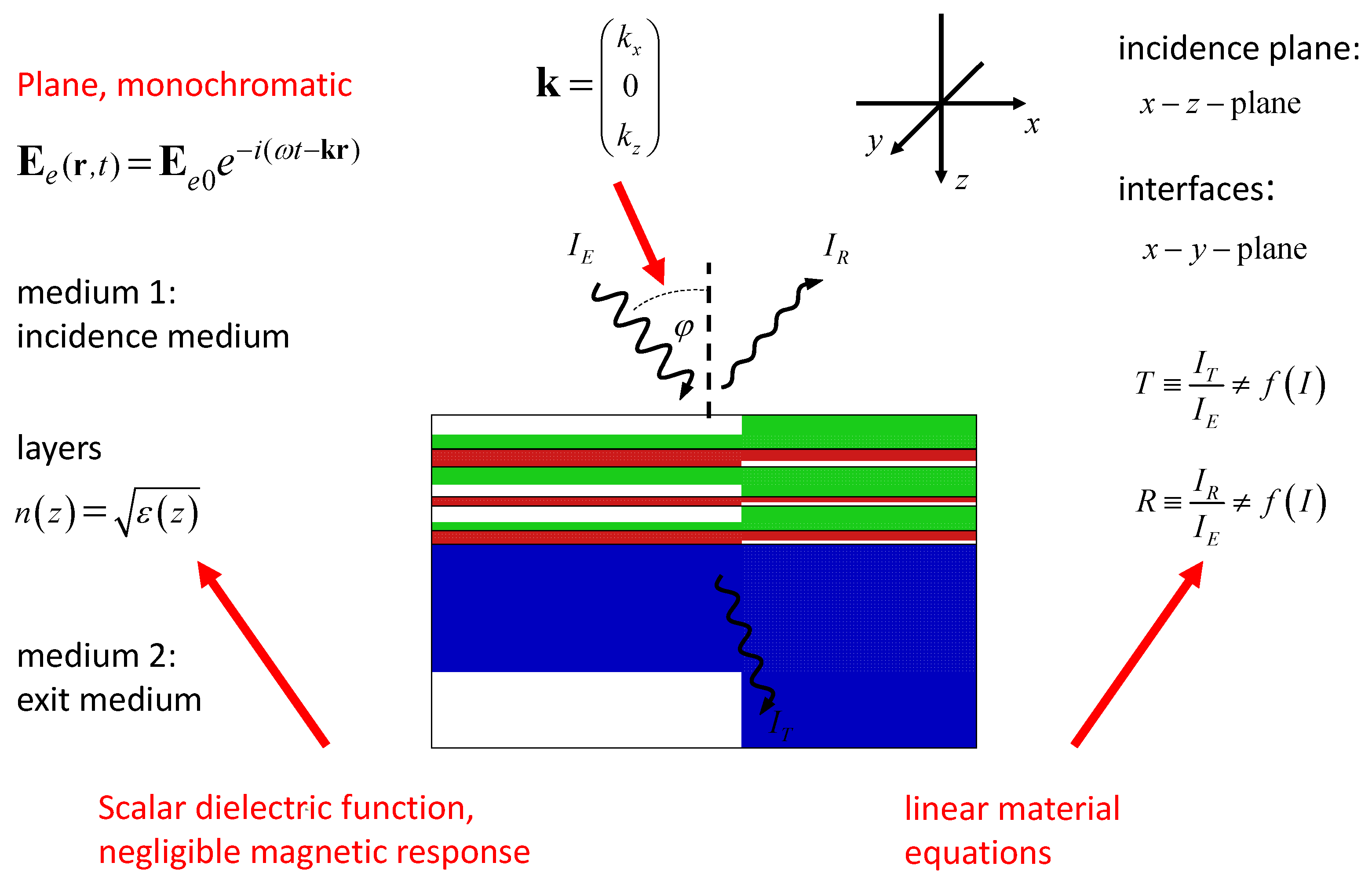

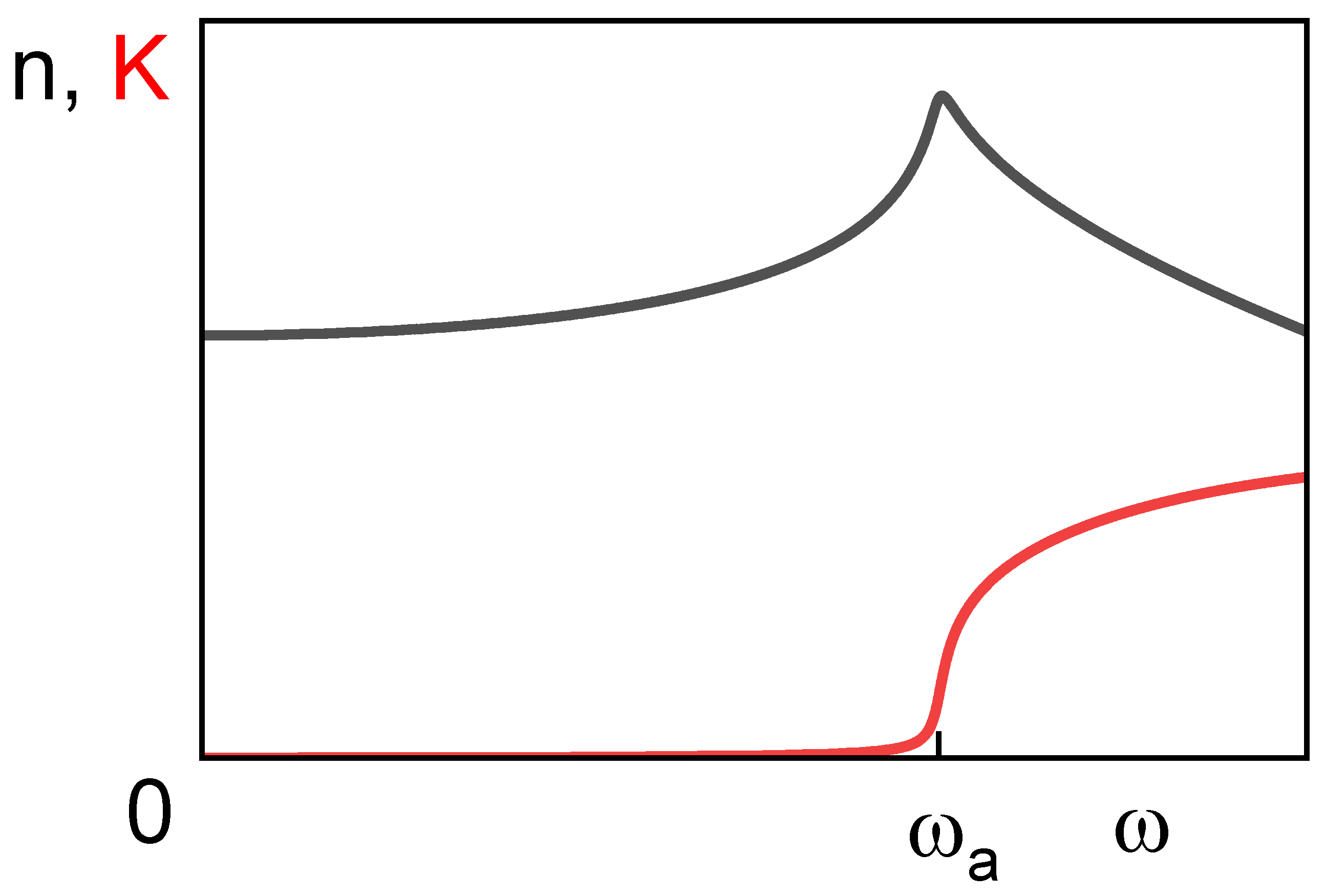
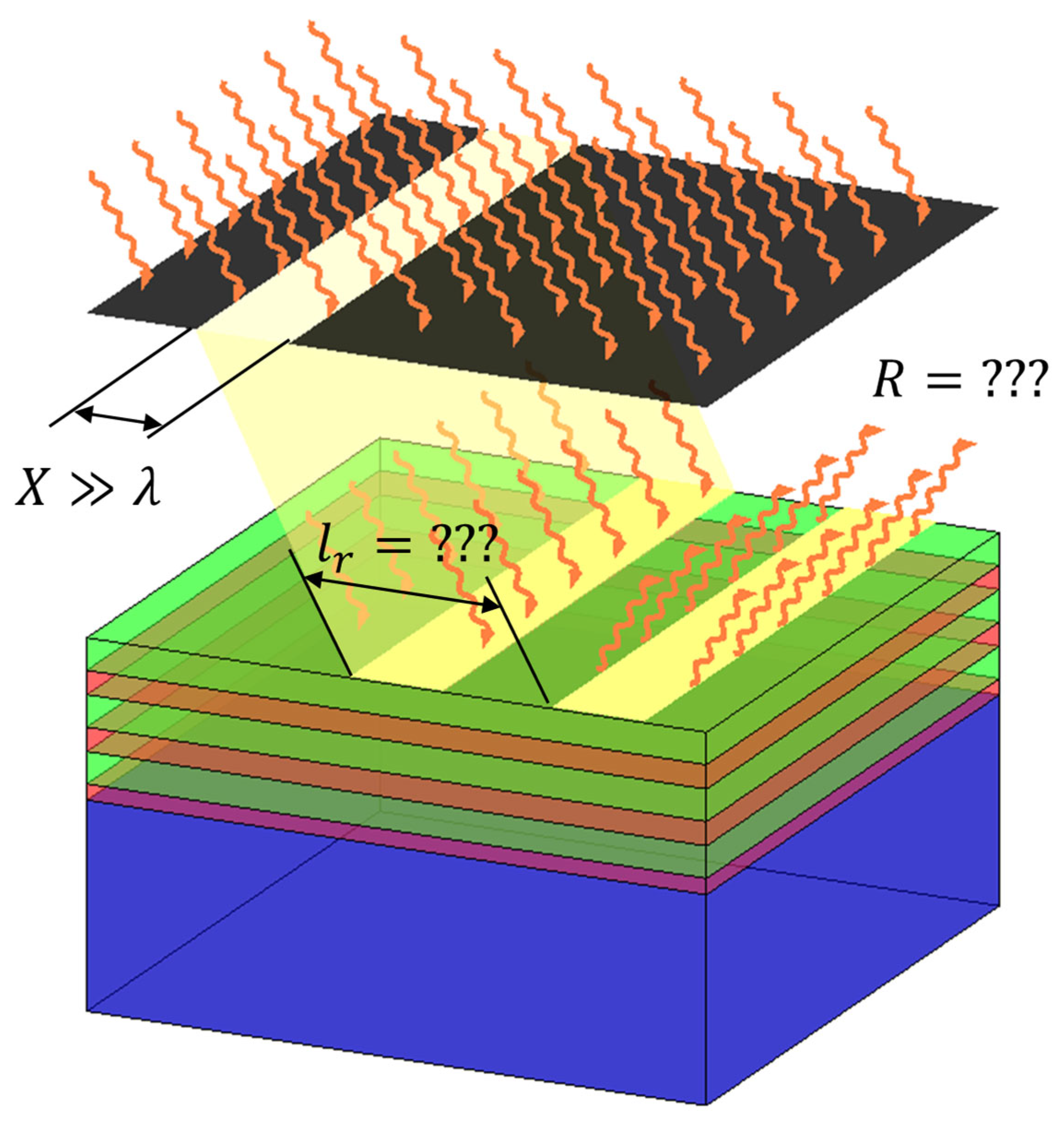
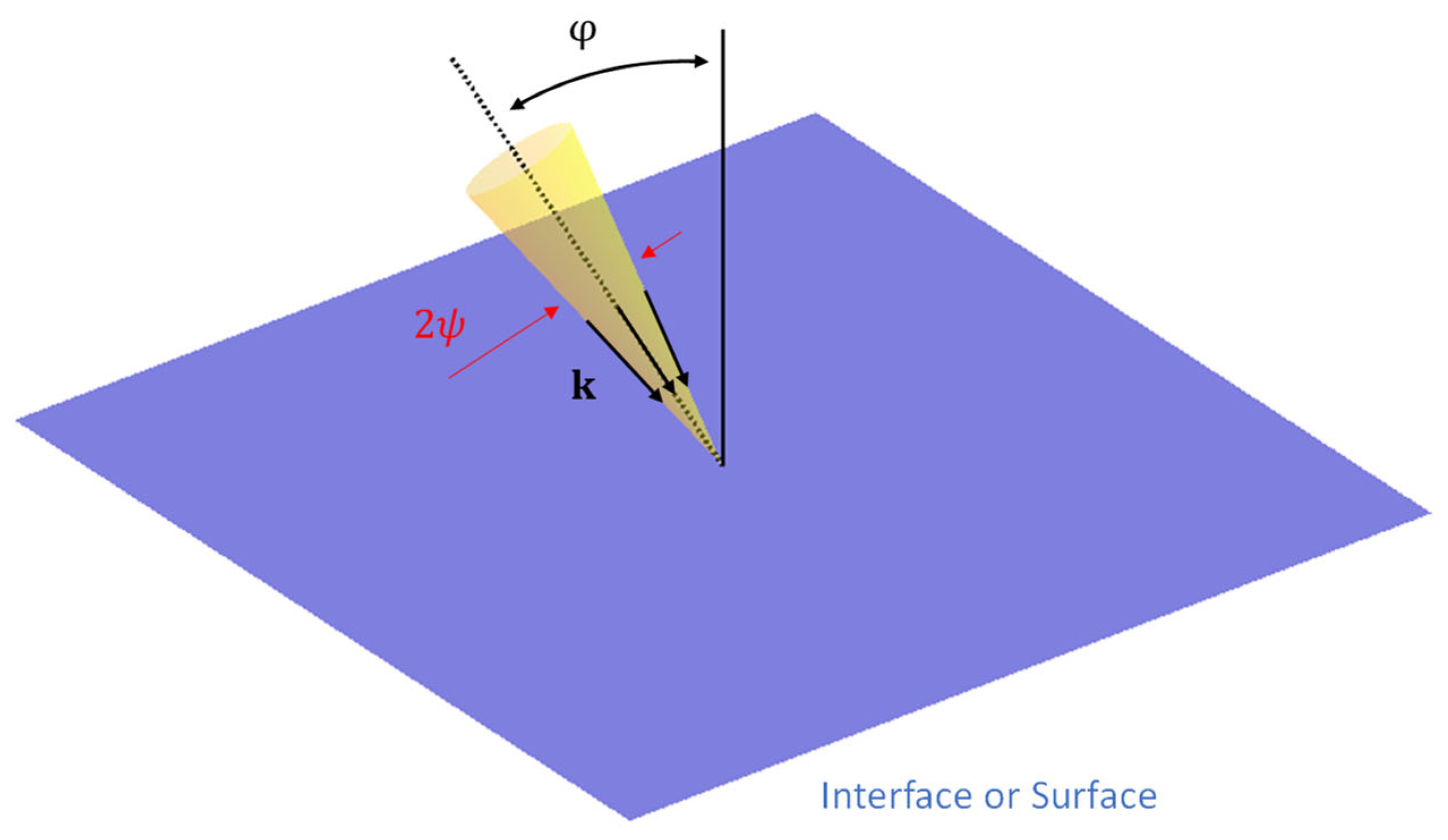
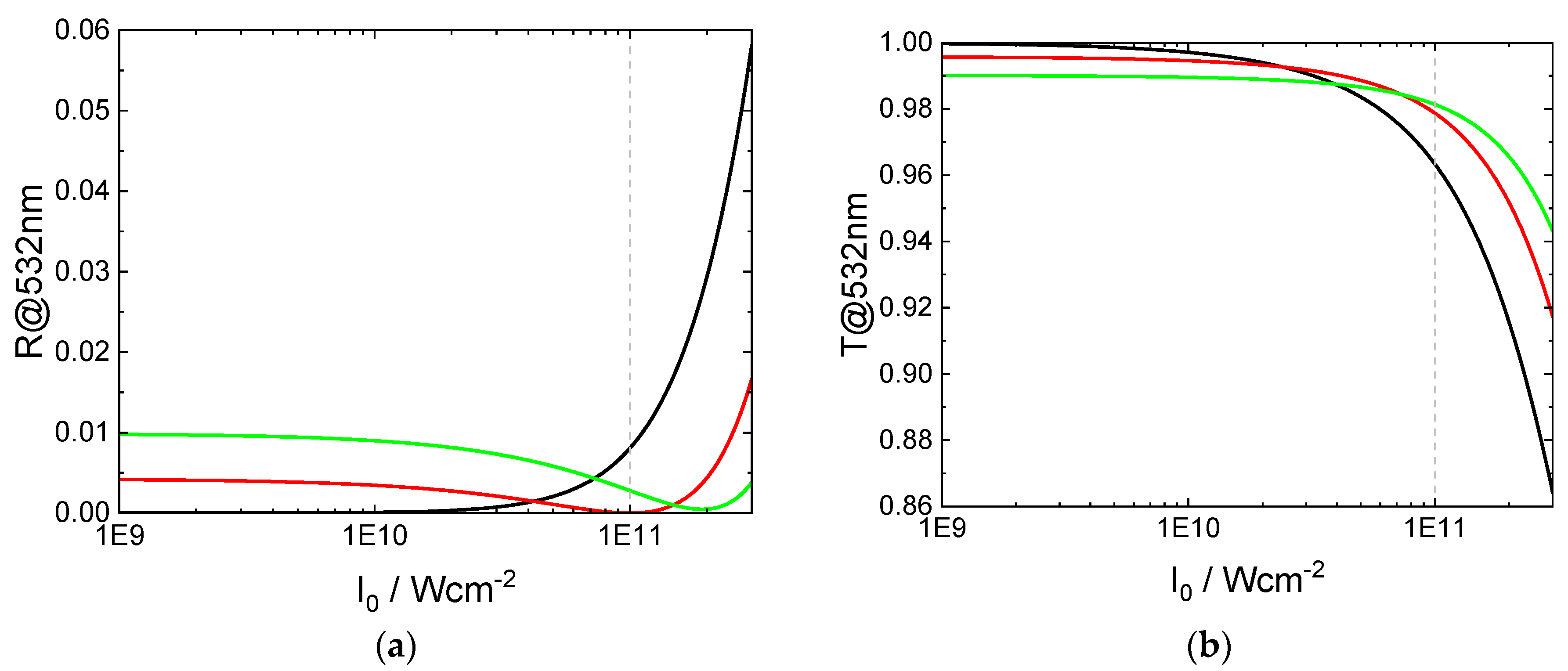
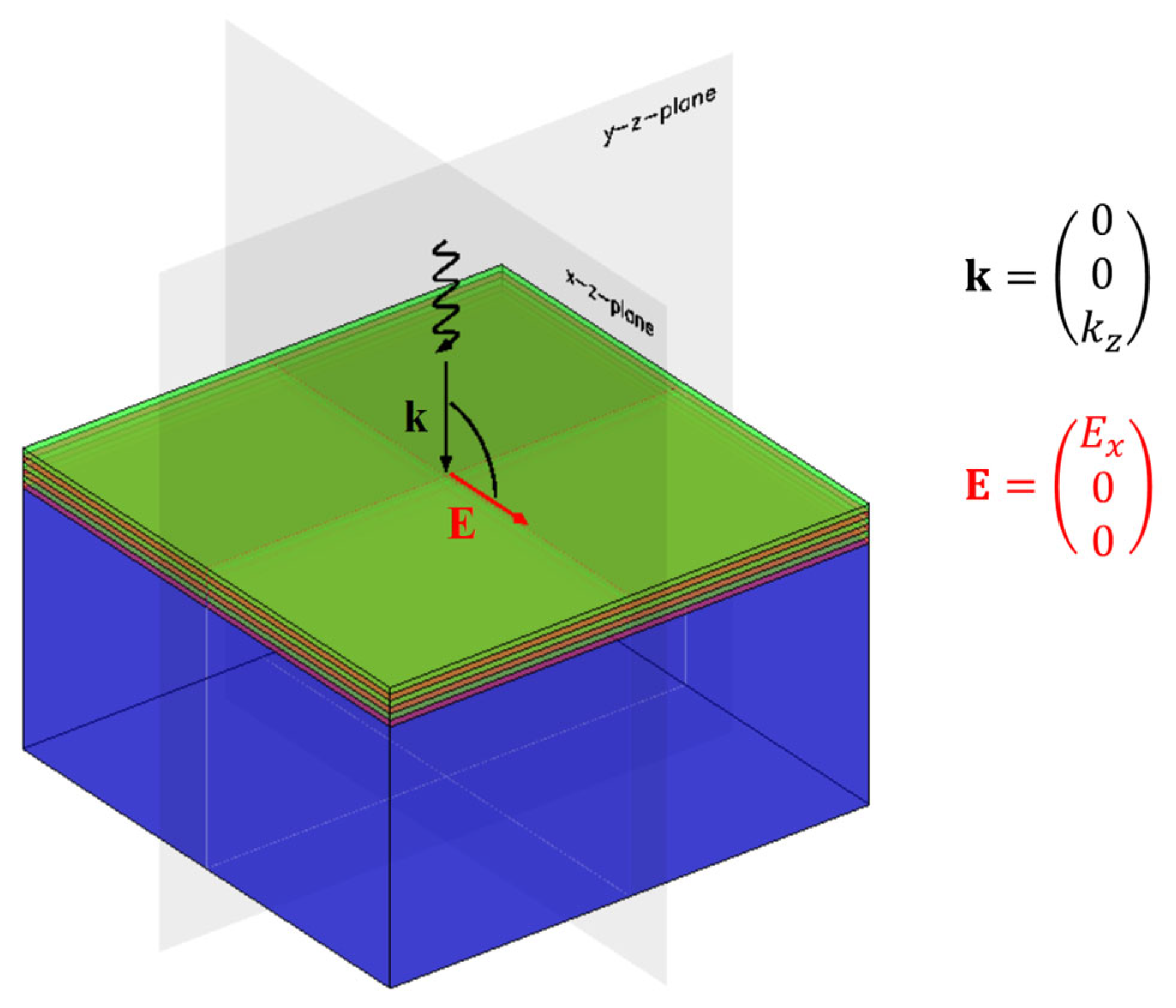
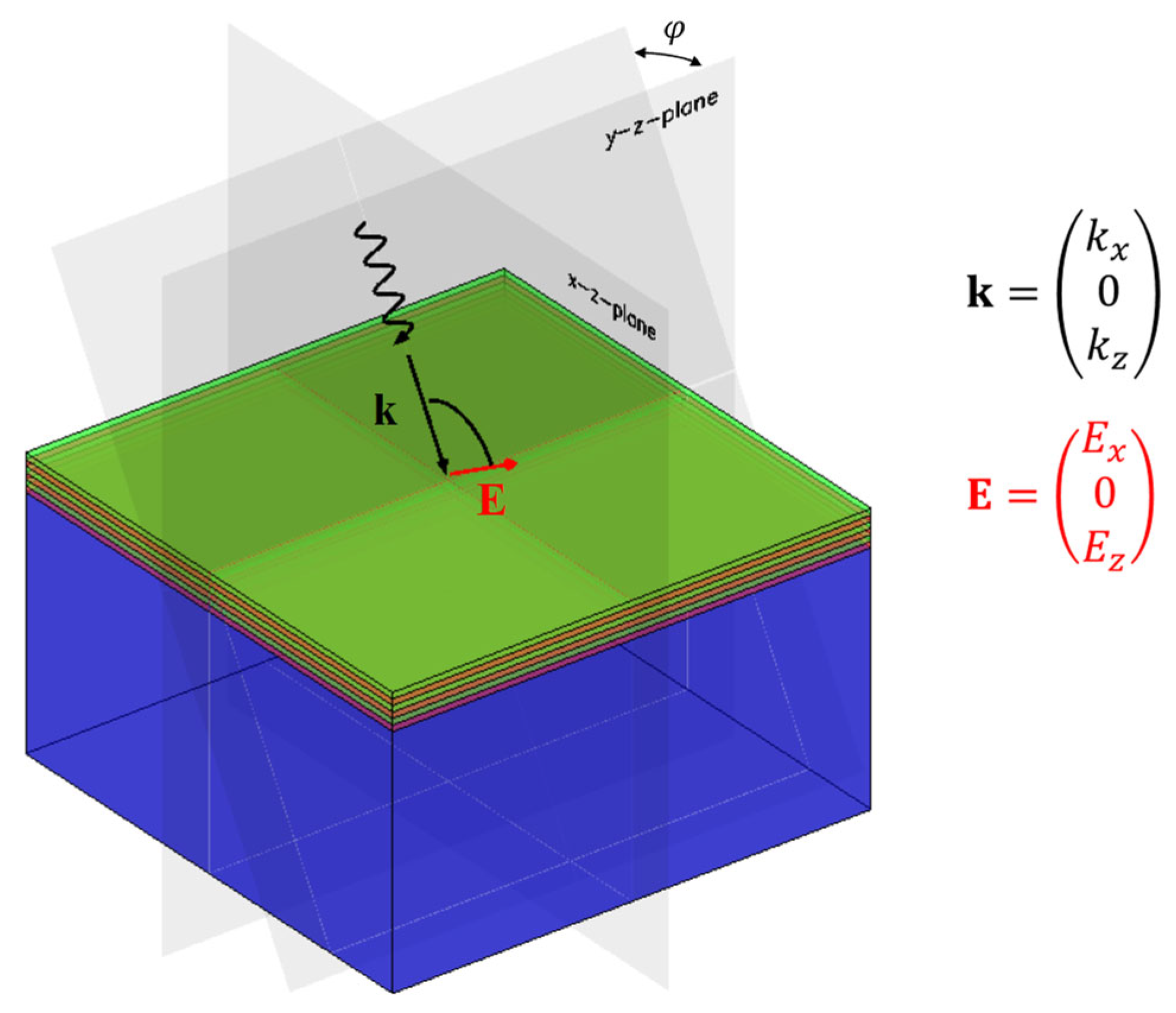
| Ref. | ||
|---|---|---|
| [56] | ||
| [58] | ||
| [70,71,72,75,85] | ||
| [77] | ||
| [79] |
| Reχ(3) /m2V−2 | Imχ(3) /m2V−2 | Thicknesses/nm | |||||
|---|---|---|---|---|---|---|---|
| V-Coating | R-Optimized Design | T-Optimized Design | |||||
| Layer 1 | 2.249 | 0 | 1.86·10−20 | 2.74·10−21 | 17.5 | 11.7 | 8.4 |
| Layer 2 | 1.477 | 0 | 2.05·10−22 | 7.32·10−24 | 121.5 | 122.4 | 125.8 |
Disclaimer/Publisher’s Note: The statements, opinions and data contained in all publications are solely those of the individual author(s) and contributor(s) and not of MDPI and/or the editor(s). MDPI and/or the editor(s) disclaim responsibility for any injury to people or property resulting from any ideas, methods, instructions or products referred to in the content. |
© 2025 by the authors. Licensee MDPI, Basel, Switzerland. This article is an open access article distributed under the terms and conditions of the Creative Commons Attribution (CC BY) license (https://creativecommons.org/licenses/by/4.0/).
Share and Cite
Stenzel, O.; Wilbrandt, S. Theoretical Aspects of Thin Film Optical Spectra: Underlying Models, Model Restrictions and Inadequacies, Algorithms, and Challenges. Appl. Sci. 2025, 15, 2187. https://doi.org/10.3390/app15042187
Stenzel O, Wilbrandt S. Theoretical Aspects of Thin Film Optical Spectra: Underlying Models, Model Restrictions and Inadequacies, Algorithms, and Challenges. Applied Sciences. 2025; 15(4):2187. https://doi.org/10.3390/app15042187
Chicago/Turabian StyleStenzel, Olaf, and Steffen Wilbrandt. 2025. "Theoretical Aspects of Thin Film Optical Spectra: Underlying Models, Model Restrictions and Inadequacies, Algorithms, and Challenges" Applied Sciences 15, no. 4: 2187. https://doi.org/10.3390/app15042187
APA StyleStenzel, O., & Wilbrandt, S. (2025). Theoretical Aspects of Thin Film Optical Spectra: Underlying Models, Model Restrictions and Inadequacies, Algorithms, and Challenges. Applied Sciences, 15(4), 2187. https://doi.org/10.3390/app15042187






